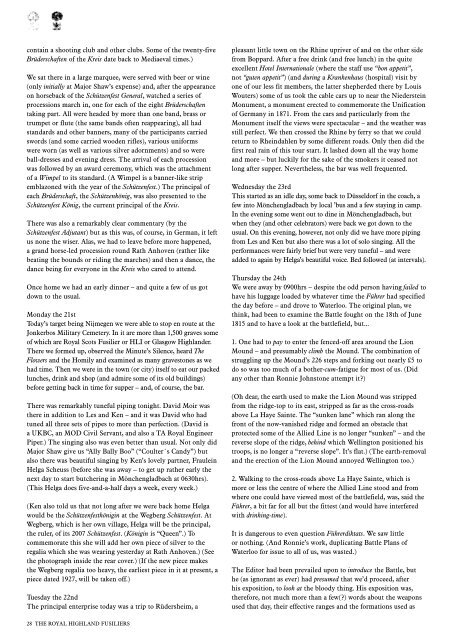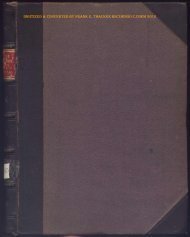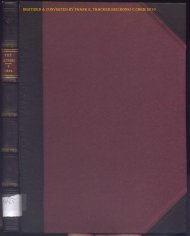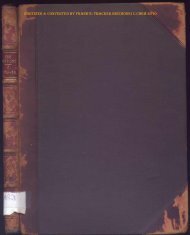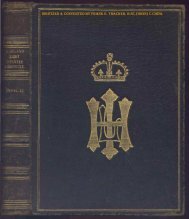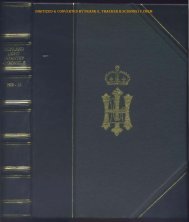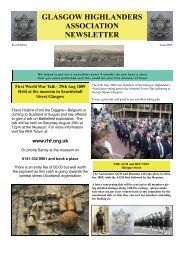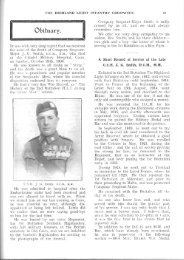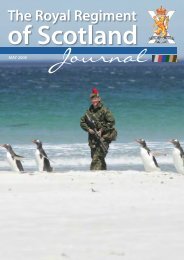Journal 2008 - The Journal Royal Highland Fusiliers - The Royal ...
Journal 2008 - The Journal Royal Highland Fusiliers - The Royal ...
Journal 2008 - The Journal Royal Highland Fusiliers - The Royal ...
Create successful ePaper yourself
Turn your PDF publications into a flip-book with our unique Google optimized e-Paper software.
contain a shooting club and other clubs. Some of the twenty-fiveBrüderschaften of the Kreis date back to Mediaeval times.)We sat there in a large marquee, were served with beer or wine(only initially at Major Shaw’s expense) and, after the appearanceon horseback of the Schützenfest General, watched a series ofprocessions march in, one for each of the eight Brüderschaftentaking part. All were headed by more than one band, brass ortrumpet or flute (the same bands often reappearing), all hadstandards and other banners, many of the participants carriedswords (and some carried wooden rifles), various uniformswere worn (as well as various silver adornments) and so wereball-dresses and evening dress. <strong>The</strong> arrival of each processionwas followed by an award ceremony, which was the attachmentof a Wimpel to its standard. (A Wimpel is a banner-like stripemblazoned with the year of the Schützenfest.) <strong>The</strong> principal ofeach Brüderschaft, the Schützenkönig, was also presented to theSchützenfest König, the current principal of the Kreis.<strong>The</strong>re was also a remarkably clear commentary (by theSchützenfest Adjutant) but as this was, of course, in German, it leftus none the wiser. Alas, we had to leave before more happened,a grand horse-led procession round Rath Anhoven (rather likebeating the bounds or riding the marches) and then a dance, thedance being for everyone in the Kreis who cared to attend.Once home we had an early dinner – and quite a few of us gotdown to the usual.Monday the 21stToday’s target being Nijmegen we were able to stop en route at theJonkerbos Military Cemetery. In it are more than 1,500 graves someof which are <strong>Royal</strong> Scots Fusilier or HLI or Glasgow <strong>Highland</strong>er.<strong>The</strong>re we formed up, observed the Minute’s Silence, heard <strong>The</strong>Flowers and the Homily and examined as many gravestones as wehad time. <strong>The</strong>n we were in the town (or city) itself to eat our packedlunches, drink and shop (and admire some of its old buildings)before getting back in time for supper – and, of course, the bar.<strong>The</strong>re was remarkably tuneful piping tonight. David Moir wasthere in addition to Les and Ken – and it was David who hadtuned all three sets of pipes to more than perfection. (David isa UKBC, an MOD Civil Servant, and also a TA <strong>Royal</strong> EngineerPiper.) <strong>The</strong> singing also was even better than usual. Not only didMajor Shaw give us “Ally Bally Boo” (“Coulter´s Candy”) butalso there was beautiful singing by Ken’s lovely partner, FrauleinHelga Scheuss (before she was away – to get up rather early thenext day to start butchering in Mönchengladbach at 0630hrs).(This Helga does five-and-a-half days a week, every week.)(Ken also told us that not long after we were back home Helgawould be the Schützenfestkönigin at the Wegberg Schützenfest. AtWegberg, which is her own village, Helga will be the principal,the ruler, of its 2007 Schützenfest. (Königin is “Queen”.) Tocommemorate this she will add her own piece of silver to theregalia which she was wearing yesterday at Rath Anhoven.) (Seethe photograph inside the rear cover.) (If the new piece makesthe Wegberg regalia too heavy, the earliest piece in it at present, apiece dated 1927, will be taken off.)Tuesday the 22nd<strong>The</strong> principal enterprise today was a trip to Rüdersheim, apleasant little town on the Rhine upriver of and on the other sidefrom Boppard. After a free drink (and free lunch) in the quiteexcellent Hotel Internationale (where the staff use “bon appetit”,not “guten appetit”) (and during a Krankenhaus (hospital) visit byone of our less fit members, the latter shepherded there by LouisWouters) some of us took the cable cars up to near the NiedersteinMonument, a monument erected to commemorate the Unificationof Germany in 1871. From the cars and particularly from theMonument itself the views were spectacular – and the weather wasstill perfect. We then crossed the Rhine by ferry so that we couldreturn to Rheindahlen by some different roads. Only then did thefirst real rain of this tour start. It lashed down all the way homeand more – but luckily for the sake of the smokers it ceased notlong after supper. Nevertheless, the bar was well frequented.Wednesday the 23rdThis started as an idle day, some back to Düsseldorf in the coach, afew into Mönchengladbach by local ’bus and a few staying in camp.In the evening some went out to dine in Mönchengladbach, butwhen they (and other celebrators) were back we got down to theusual. On this evening, however, not only did we have more pipingfrom Les and Ken but also there was a lot of solo singing. All theperformances were fairly brief but were very tuneful – and wereadded to again by Helga’s beautiful voice. Bed followed (at intervals).Thursday the 24thWe were away by 0900hrs – despite the odd person having failed tohave his luggage loaded by whatever time the Führer had specifiedthe day before – and drove to Waterloo. <strong>The</strong> original plan, wethink, had been to examine the Battle fought on the 18th of June1815 and to have a look at the battlefield, but...1. One had to pay to enter the fenced-off area around the LionMound – and presumably climb the Mound. <strong>The</strong> combination ofstruggling up the Mound’s 226 steps and forking out nearly £5 todo so was too much of a bother-cum-fatigue for most of us. (Didany other than Ronnie Johnstone attempt it?)(Oh dear, the earth used to make the Lion Mound was strippedfrom the ridge-top to its east, stripped as far as the cross-roadsabove La Haye Sainte. <strong>The</strong> “sunken lane” which ran along thefront of the now-vanished ridge and formed an obstacle thatprotected some of the Allied Line is no longer “sunken” – and thereverse slope of the ridge, behind which Wellington positioned histroops, is no longer a “reverse slope”. It’s flat.) (<strong>The</strong> earth-removaland the erection of the Lion Mound annoyed Wellington too.)2. Walking to the cross-roads above La Haye Sainte, which ismore or less the centre of where the Allied Line stood and fromwhere one could have viewed most of the battlefield, was, said theFührer, a bit far for all but the fittest (and would have interferedwith drinking-time).It is dangerous to even question Führerdiktats. We saw littleor nothing. (And Ronnie’s work, duplicating Battle Plans ofWaterloo for issue to all of us, was wasted.)<strong>The</strong> Editor had been prevailed upon to introduce the Battle, buthe (as ignorant as ever) had presumed that we’d proceed, afterhis exposition, to look at the bloody thing. His exposition was,therefore, not much more than a few(?) words about the weaponsused that day, their effective ranges and the formations used as28 THE ROYAL HIGHLAND FUSILIERS


